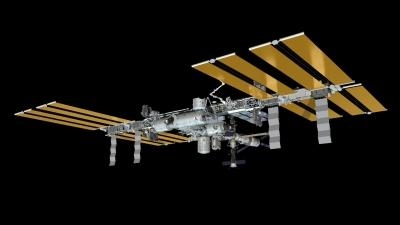BSN, NASA Collaborate Exclusively On Solution For Orthostatic Intolerance Following Long-Duration Spaceflight
One of the side effects of long-duration space flight is a condition called post-spaceflight orthostatic intolerance -- the inability to stand upright without experiencing a rapid heart rate, low blood pressure (hypotension), lightheadedness or feeling faint upon return to Earth's gravity.

Medical therapy solutions provider BSN Medical recently announced an ongoing collaboration with NASA to develop a specialized gradient compression garment for protection against the condition.
Astronauts who live in space, even for short periods of time, experience physiological adaptations that have noticeable consequences once they return to Earth's gravity. These include changes to balance, coordination, muscle strength, blood volume, and blood pressure regulation, and may impact an astronaut's ability to perform basic tasks such as standing and walking1. According to a study of veteran astronauts, up to 83 percent returning from long duration ( > 1 mo.) spaceflight experienced these physiological changes during postflight evaluation.
Since 2009, Michael B. Stenger, Ph.D., Cardiovascular and Vision Laboratory Lead, and Stuart M. C. Lee, Ph.D., Lead Scientist in the Cardiovascular and Vision Laboratory at the NASA Johnson Space Center have been examining the usefulness of different configurations of BSN's JOBST® lower body compression garments as a countermeasure to post-spaceflight orthostatic intolerance. This work has led to the development of a custom-fitted, three-piece, abdomen-high, elastic gradient compression garment designed by BSN engineers. The efficacy of the three-piece compression garments first was demonstrated in healthy subjects following a 14-day bed rest study, an analog of space flight, and in astronauts after two-week Space Shuttle missions. The positive results from these studies were published in peer-reviewed scientific journals, including the report by M.B. Stenger, et al., published in Aviation, Space, and Environmental Medicine.
Currently, the JOBST three-piece garments are being tested in astronauts returning from four-to-six month stays on the International Space Station (ISS) as part of the joint NASA-Russian Field Test Study. Upon landing in Kazakhstan, crewmembers are taken into a medical tent where they remove their space suits, put on the JOBST gradient compression garments, and participate in the Field Test study protocols. Testing at the landing site includes quickly standing from a seated position, standing quietly for 3.5 minutes after rising from a prone position, walking a straight line, walking over a small obstacle, and posture testing. To date, only a few astronauts have worn the JOBST gradient compression garments during the Field Test, but preliminary observations are promising. Conclusive evidence will not be available until the study is completed.
Scientists plan to test a total of 15 crewmembers before deciding whether to transition the JOBST three-piece compression garments from research to normal usage. In the future, the garments might be used for crews traveling to and from the ISS, as well as to Mars and other destinations. Prior to launch, the patented JOBST garments are custom-fitted to each astronaut taking part in the Field Test investigation, and they are designed to accommodate for moderate changes in body weight and size, all of which may occur as a result of prolonged stays in space.
"Our team is extremely pleased to be working so closely with NASA," said Felix Dahm, M.D., executive vice president of Innovation and Strategic Development for BSN medical. "The demands of space flight place significant physiological stress on astronauts. Our gradient compression garments have been shown to alleviate post-spaceflight orthostatic intolerance in ongoing studies. We have a world-class team of engineers who are committed to improving compression therapies -- an expertise that also helps prevent certain adverse effects of space flight."
"Additionally, NASA's research with the JOBST garments may also help the general population overcome issues such as orthostatic intolerance, as these garments designed for astronauts may hold promise for people who suffer from sudden drops in blood pressure on a regular basis here on earth," continued Dr. Dahm.
Upon entering the weightless environment of space, an astronaut's blood moves upwards from their legs to the upper body and head, and blood volume decreases in the first 24 hours of space flight. When they re-enter Earth's gravity and land, blood moves back towards their lower body and the body's mechanisms to return blood back to the heart are not as effective. Consequently, 20 percent of Space Shuttle astronauts did and more than 60 percent of International Space astronauts may experience hypotension, causing them to feel lightheaded and dizzy. Recovery from the effects of space flight can take several days to weeks depending on the length of the mission and the individual astronaut. As a result, orthostatic intolerance can persist for several days after landing.
(Source: BSN Medical news release. NASA image from file)
 Airborne 04.16.24: RV Update, Affordable Flying Expo, Diamond Lil
Airborne 04.16.24: RV Update, Affordable Flying Expo, Diamond Lil ANN's Daily Aero-Term (04.20.24): Light Gun
ANN's Daily Aero-Term (04.20.24): Light Gun Aero-News: Quote of the Day (04.20.24)
Aero-News: Quote of the Day (04.20.24) Aero-News: Quote of the Day (04.21.24)
Aero-News: Quote of the Day (04.21.24) ANN's Daily Aero-Term (04.21.24): Aircraft Conflict
ANN's Daily Aero-Term (04.21.24): Aircraft Conflict



